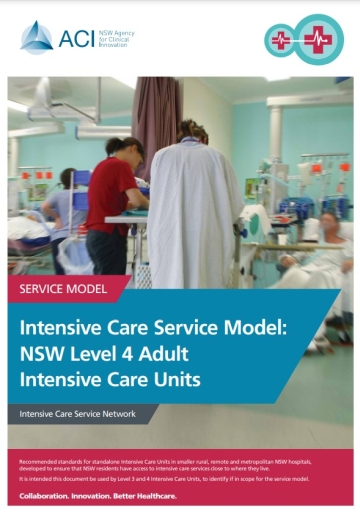Published: July 2015. Next review: 2024.
Intensive care services are a precious and costly resource, which need to be consistently, safely and efficiently provided.
The Intensive Care Service Model provides recommended standards for the safe and efficient delivery of care in level 4 intensive care units (ICUs), to improve the care of the critically ill patient.
Implementation of the service model across NSW will improve delivery of intensive care services and the care of the critically ill patient in rural, remote and metropolitan hospitals.
Download the Intensive care service model NSW level 4 adult intensive care units (PDF 2.0 MB)
Implementation resources
- Implementation guide (PDF 576.4 KB)
Use this guide to review the steps involved in planning, assessing and operationalising your implementation.
Published: January 2016. Next review: 2025.
Planning
Use these resources to assess your readiness to implement the service model.
- Self-assessment Gap Analysis Medical Records Audit Tool (XLS 37.5 KB)
Published: April 2019. Next review: 2024 - Self-assessment Tool (XLS 740.2 KB)
Published: June 2019. Next review: 2024
Communication
These infographics have summary information to help you communicate about the implementation with your stakeholders.
- Patient infographic (PDF 284.4 KB)
Published 2017. Next review 2025. - Staff infographic (PDF 236.2 KB)
Published 2017. Next review 2025.
Implementation of the service model
Implementation of the service model has taken a flexible and tailored approach to ensure sustainability at the sites. The approach has supported the service redesign at each facility, including the following steps.
- Identify the gaps between the recommended standards and current practice by undertaking the structured self-assessment.
- Review the outcomes of the findings and undertake further diagnostic activities (e.g. IIMS, retrieval and service activity data, patient and staff surveys, complaints, process mapping and review) as required to better understand local issues and prioritise these as appropriate.
- Identify and develop solutions for gaps and service deficiencies, including:
- assess the magnitude of the solutions (including what is in and out of scope)
- assess the resources required (if any)
- consider the timeframe required to fully implement the service model
- review potential risks and challenges to implement the service model and consider how these maybe managed.
- Develop an implementation plan for each solution identified.
- Implement sustainable change through:
- communication
- evaluation
- ongoing monitoring of service delivery under the new service model and reinforcement of outcomes
- sharing achievements, innovations and new processes with key stakeholders.
Staff experience
In this video, staff in NSW ICUs talk about their experiences implementing the model.
Benefits and outcomes
Expected benefits of implementing the service model include the following.
For patients
- Improved quality and safety of care delivered to the critically ill patient
- Improved coordination of care
- Reduction of unplanned admissions, length of stay and transfers
- Improved experiences and journeys (supported by evidence that shows ICUs lead by intensivists have reduced mortality rates)
- Access to intensive care close to where they live
For staff
- Improve support of staff in the delivery of care to critically ill patients
- Improve access to 24/7 senior critical care advice
- Improve access critical care to resources across the local health district (LHD)
- Improved staff experience
For the local health district
- A networked approach rather than a unit approach to the delivery of intensive care services and use of LHD intensive care resources
- Reduced unplanned admissions, length of stay, transfers and retrievals translate into better coordinated patient care
- Enhanced critical care functions across the LHD, improving support of inpatient surgical and medical activity
The broader NSW health system
- Standardised delivery of intensive care services in rural, remote and metropolitan NSW hospitals
- Strengthened and sustained functions required to support the inpatient critical care needs of NSW
- Reduction in unplanned admissions, length of stay, transfers and retrievals translating into better coordinated patient care and significant cost savings to NSW Health
